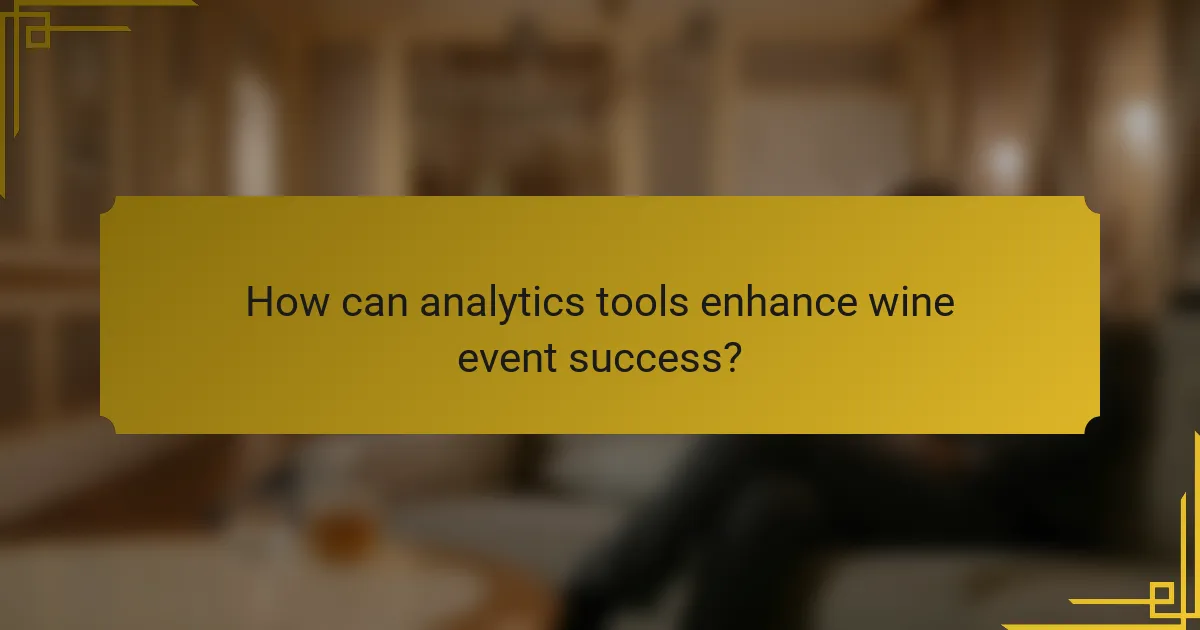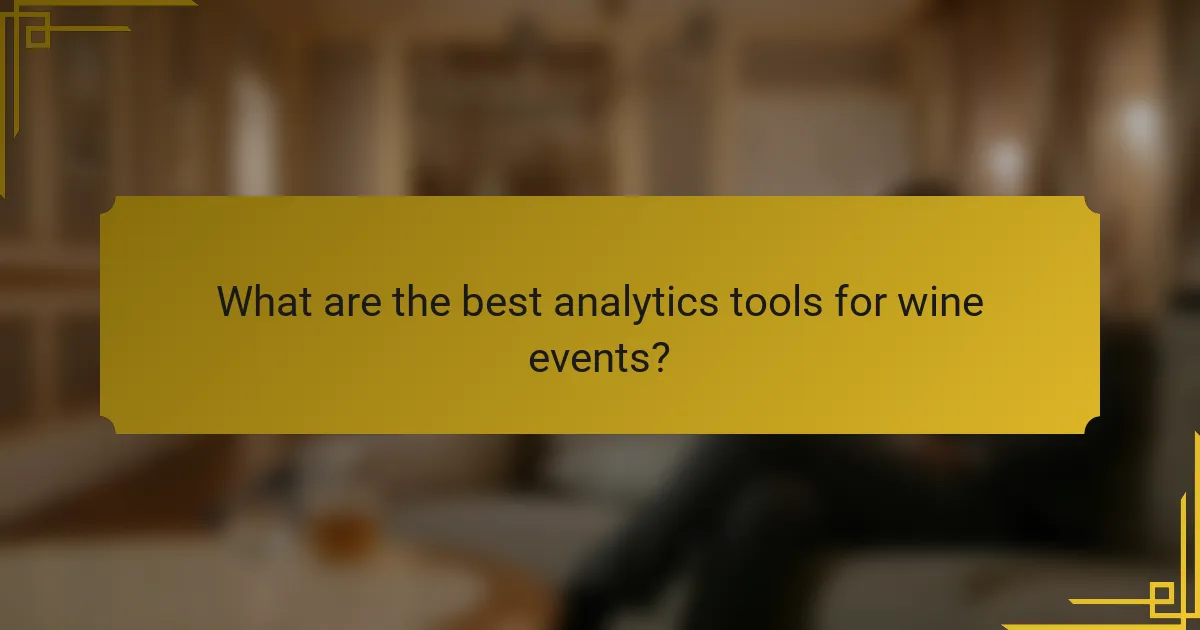Analytics tools play a crucial role in enhancing the success of wine events by offering valuable insights into attendee behavior and preferences. By utilizing these tools, event organizers can make data-driven decisions that improve engagement and refine marketing strategies, ultimately leading to a more impactful event experience.

How can analytics tools enhance wine event success?
Analytics tools can significantly boost the success of wine events by providing insights into attendee behavior, preferences, and overall event performance. By leveraging data, event organizers can make informed decisions that enhance engagement and optimize marketing efforts.
Improved attendee engagement
Analytics tools help to understand attendee interests and behaviors, allowing organizers to tailor experiences that resonate with participants. For example, tracking which wine tastings attract the most visitors can inform future event planning and enhance the overall experience.
Engagement can also be improved through personalized communication. By analyzing data from past events, organizers can send targeted invitations and follow-ups, increasing the likelihood of attendance and participation.
Data-driven marketing strategies
Utilizing analytics enables wine event organizers to craft marketing strategies based on actual data rather than assumptions. By identifying demographics and preferences, targeted advertising can be employed to reach the right audience effectively.
For instance, if analytics reveal that a significant portion of attendees prefer organic wines, marketing efforts can focus on promoting organic selections in future events. This targeted approach often leads to higher conversion rates and better ROI.
Real-time performance tracking
Real-time analytics provide immediate feedback on various aspects of the event, such as ticket sales, attendee check-ins, and engagement levels during sessions. This allows organizers to make quick adjustments if certain areas are underperforming.
For example, if a particular wine tasting is not attracting attendees, organizers can promote it through social media or offer incentives to encourage participation. This agility can enhance the overall success of the event.
Post-event analysis
After the event, analytics tools allow for a comprehensive review of performance metrics, including attendance rates, sales figures, and attendee feedback. This analysis is crucial for understanding what worked well and what could be improved for future events.
Organizers can compile reports that highlight key findings, such as the most popular wines or sessions, and use this information to refine their strategies. Regular post-event analysis can lead to continuous improvement and greater success in subsequent wine events.

What are the best analytics tools for wine events?
The best analytics tools for wine events include Google Analytics, Eventbrite, Tableau, and various social media analytics platforms. These tools help organizers measure success, track engagement, and gain insights into attendee behavior and preferences.
Google Analytics for event tracking
Google Analytics is essential for tracking website traffic and user interactions related to wine events. By setting up event tracking, you can monitor how visitors engage with your event pages, including ticket purchases and information requests.
To effectively use Google Analytics, create specific goals for your event, such as ticket sales or newsletter sign-ups. This will allow you to measure conversion rates and identify which marketing channels drive the most traffic.
Eventbrite for ticket sales insights
Eventbrite provides detailed analytics on ticket sales and attendee demographics for wine events. You can access real-time data on ticket sales, revenue, and attendee sources, helping you understand which promotions are most effective.
Utilize Eventbrite’s reporting features to analyze trends over time, such as peak sales periods or popular ticket types. This information can guide your future marketing strategies and pricing decisions.
Tableau for data visualization
Tableau is a powerful tool for visualizing complex data sets related to wine events. It allows you to create interactive dashboards that display ticket sales, attendee demographics, and engagement metrics in a visually appealing format.
When using Tableau, focus on key performance indicators (KPIs) relevant to your event goals. This could include metrics like average ticket price, total attendance, or social media engagement rates, enabling you to make data-driven decisions.
Social media analytics tools
Social media analytics tools, such as Hootsuite or Sprout Social, help you track engagement and reach for your wine event promotions. These platforms provide insights into how your posts perform across different channels, allowing you to adjust your strategy accordingly.
Monitor metrics like likes, shares, comments, and click-through rates to gauge audience interest. Use this data to refine your content and targeting, ensuring your messaging resonates with potential attendees.

What metrics should be measured at wine events?
Measuring key metrics at wine events is essential for evaluating success and gaining insights. Focus on attendee demographics, sales conversion rates, social media engagement, and feedback to understand the event’s impact and areas for improvement.
Attendee demographics
Understanding attendee demographics helps tailor future events and marketing strategies. Collect data on age, gender, location, and preferences to create targeted promotions and enhance the overall experience.
For example, if a significant portion of attendees are young professionals, consider incorporating modern trends in wine selection and event themes. Use surveys or registration forms to gather this information effectively.
Sales conversion rates
Sales conversion rates indicate how many attendees made purchases during the event. Tracking this metric helps assess the effectiveness of sales strategies and product offerings.
To calculate conversion rates, divide the number of purchases by the total number of attendees. A conversion rate of 10-20% is often considered successful for wine events, depending on the target audience and offerings.
Social media engagement
Social media engagement measures how attendees interact with your brand online during and after the event. This includes likes, shares, comments, and mentions across platforms like Instagram, Facebook, and Twitter.
Encourage attendees to post using a specific hashtag or tag your event’s account. Monitor engagement levels to gauge the event’s reach and impact, aiming for a steady increase in interactions compared to previous events.
Feedback and satisfaction scores
Collecting feedback and satisfaction scores provides direct insights into attendee experiences. Use post-event surveys to ask participants about their overall satisfaction, favorite aspects, and areas for improvement.
A satisfaction score of 80% or higher is generally a good benchmark. Consider offering incentives, such as discounts on future events, to encourage more attendees to provide feedback.

How to choose the right analytics tool for wine events?
Selecting the right analytics tool for wine events involves understanding your specific needs, including event size, budget, and integration capabilities. A well-chosen tool can provide valuable insights into attendee behavior, sales performance, and overall event success.
Assessing event size and scope
The size and scope of your wine event significantly influence the type of analytics tool you should choose. For smaller, local events, a basic tool that tracks attendance and sales may suffice. In contrast, larger events with multiple sessions or venues may require more sophisticated solutions that can handle complex data sets and provide in-depth analysis.
Consider the number of attendees, the variety of activities, and the data points you wish to track. For instance, if you plan to host several tastings and workshops, look for tools that can segment data by session or activity.
Budget considerations
Your budget plays a crucial role in selecting an analytics tool for wine events. Basic tools can range from free to a few hundred dollars per month, while advanced platforms may cost thousands. Determine how much you are willing to invest based on the expected return on insights and improvements.
Keep in mind that some tools offer tiered pricing based on features. Start with a basic package and upgrade as your needs grow. Look for tools that provide a free trial or demo to assess their value before committing financially.
Integration with existing systems
Choosing an analytics tool that integrates seamlessly with your existing systems can save time and reduce errors. Check if the tool can connect with your ticketing software, CRM, or marketing platforms to streamline data collection and reporting.
For example, if you use a specific CRM to manage customer relationships, ensure the analytics tool can pull data from it. This integration allows for a more comprehensive view of attendee engagement and sales performance, enhancing your ability to make data-driven decisions.

What are the challenges of using analytics tools?
Using analytics tools presents several challenges, including data privacy concerns, integration issues, and the complexity of interpreting data. These obstacles can hinder effective decision-making and limit the insights gained from analytics.
Data privacy concerns
Data privacy is a significant challenge when using analytics tools, especially in regions with strict regulations like the EU’s GDPR. Organizations must ensure that they collect, store, and process personal data in compliance with these laws to avoid hefty fines and reputational damage.
To address data privacy concerns, businesses should implement robust data governance policies. This includes obtaining explicit consent from users, anonymizing data where possible, and regularly auditing data practices to ensure compliance with legal standards.
Additionally, transparency with event attendees about how their data will be used can build trust. Providing clear privacy policies and options to opt-out can help mitigate concerns and encourage participation in data collection efforts.
